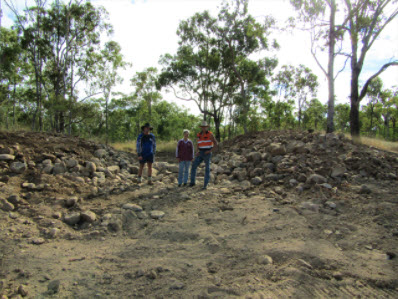Project targets sediment run-off

Theme: Environmental stewardship
Priority: Minimise nutrient and sediment loss
Producers: Williams-Waddell family
Location: Ravenshoe, Qld
KEY POINTS
- A government-funded project aims to cut sediment run-off to the Great Barrier Reef.
- Fencing is being installed to restrict cattle access to gullies and streambanks.
- Earthworks will shore up old tin mining tailings dams.
When a property has been under the same family’s care for more than a century, sustainability and succession are usually front-of-mind for its stewards.
The Williams-Waddells have been guiding Woodleigh Station at Ravenshoe for the past 105 years, during which time approaches to farming in North Queensland have evolved significantly.
Now third-generation grazier Kate Waddell is looking to the future of not only her own heritage but also the nearby Great Barrier Reef.
Woodleigh lies within the Herbert catchment, an area extending 340 kilometres from the Herberton and Ravenshoe districts to the coast and whose waters drain directly onto the reef at Ingham.
Kate’s farm might be 130 kilometres from the nearest salt water but that doesn’t mean its influence is localised. Far from it, in fact: the Herbert catchment has traditionally been one of the three biggest contributors of the harmful sediment loads to the reef.
Sediment is currently one of the major material threats to the reef. Fine sediment, in particular, poses a high risk to marine ecosystems as it smothers coral and plants including seagrass, thereby hampering their growth.
This in turn affects aquatic wildlife such as dugongs, turtles, fish and other animals that depend on these resources for food and shelter.
Kate’s family at Woodleigh is part of a new $3 million Australian Government program focused on improving water quality in the Herbert River system – the southernmost of Queensland’s ‘wet tropics’ catchments.
To be delivered by the independent for-purpose organisation Terrain NRM, the program aims to reduce fine sediment run-off into the Great Barrier Reef lagoon.
It will fund earthworks over several years to reshape gullies, changes to grazing practices, fencing to keep cattle away from streambanks, construction of off-stream watering infrastructure, revegetation and weed management.
At Woodleigh the team began by monitoring gullies and carrying out botanical surveys, then segued into fencing off areas for remediation, such as old tailings dams from the era of alluvial tin mining. Earthmoving equipment is on site as the Williams-Waddells prepare to reverse many decades’ worth of gradual degradation.
“It’s important to us to leave the land in a healthy state,” Kate said. “We want our young ones who are coming on to see the benefits and to love the land as much as we do.”
Kate said “even with good grass cover and light stocking rates”, some of Woodleigh’s silt and clay soils eroded easily in heavy rainfall.
“To improve our sustainability, over the past 10 years we’ve started wet-season spelling where we fallow our paddocks, and we’ve stopped burning.” These developments have already boosted the property’s grasses and soil biology, Kate said.
Categories: Environmental stewardship